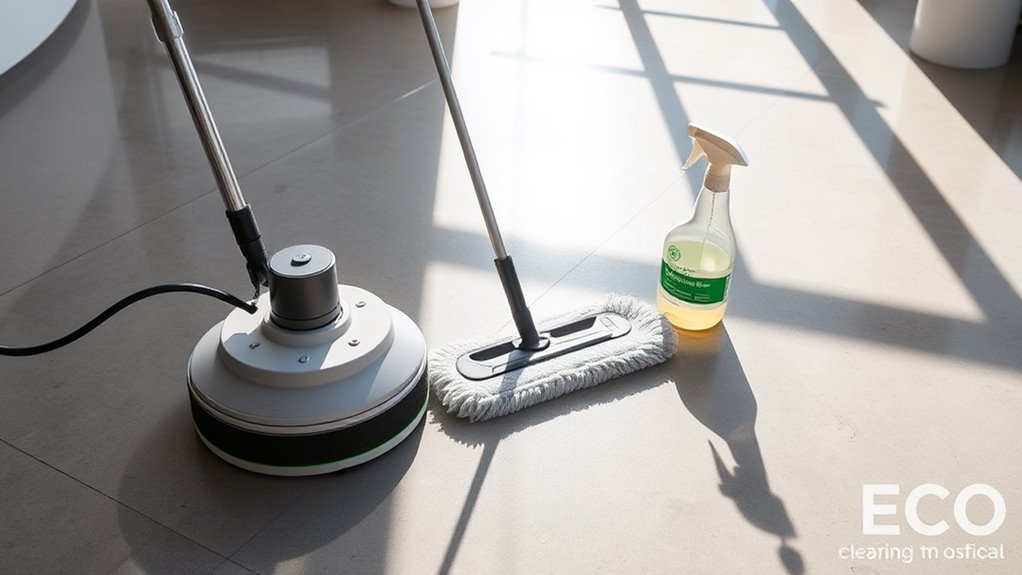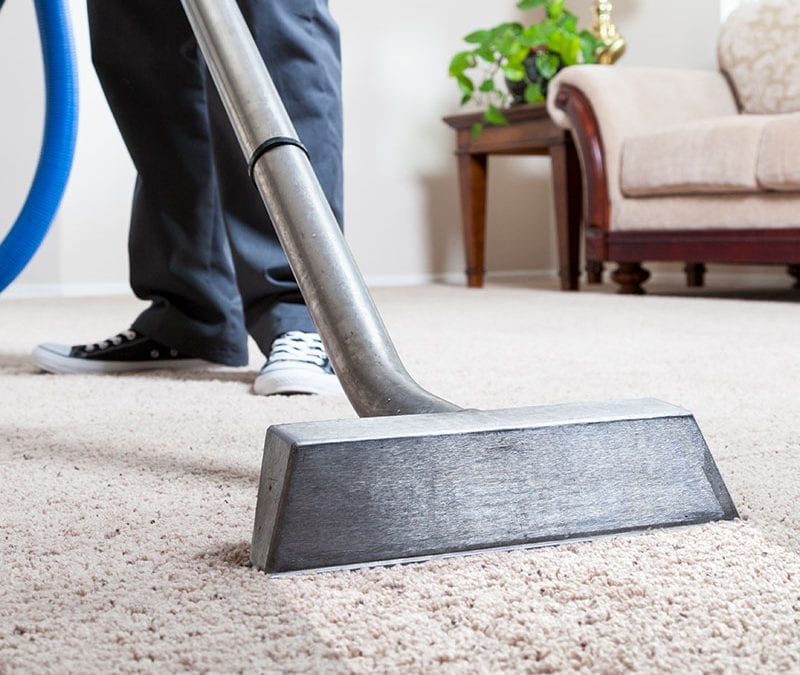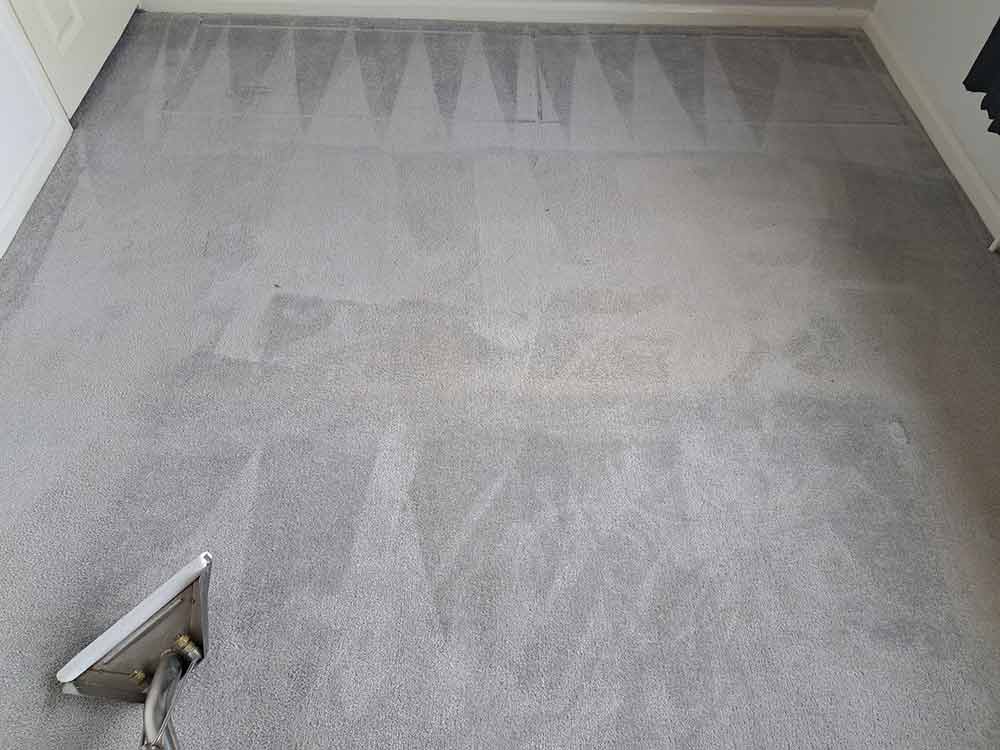Picture your polished concrete floors as a canvas, where each stain and scuff tells a story. To guarantee that story remains vibrant, you need a solid cleaning and maintenance strategy. From daily dust mopping to weekly deep cleans, every step plays an important role in preserving their beauty. But what about those stubborn stains that seem determined to mar your masterpiece? Understanding the right techniques and tools will keep your floors looking impeccable for years to come. Let's explore the essential practices that will help you maintain that polished sheen.
Daily Maintenance Tips
To effectively maintain polished concrete floors, you should engage in daily maintenance practices that are both simple and fundamental.
Start with daily dust mopping; this task is essential since dust and dirt can act like sandpaper, dulling the polished surface over time. Utilize microfiber pads, as they efficiently pick up dust particles and fine debris, preventing scratches and maintaining the floor's shine. Aim to remove dirt and grit daily to guarantee a pristine finish.
Additionally, immediate spill cleanup is critical. When spills occur, quickly blot them with a clean, dry cloth to prevent staining, particularly on light-colored or high-gloss surfaces. Rubbing can exacerbate the issue, so gentle blotting is key.
To avoid discoloration, always opt for pH-neutral cleaners, steering clear of harsh chemicals that could damage the floor's finish.
Incorporating these daily maintenance tips won't only keep your polished concrete floors looking their best but also extend their lifespan.
Weekly Deep Cleaning Routine
A weekly deep cleaning routine is essential for maintaining the appearance and longevity of polished concrete floors. By adhering to a consistent cleaning schedule, you can effectively preserve your floor's shine and prevent damage.
| Step | Action |
|---|---|
| 1 | Damp mop with warm water and pH-neutral cleaner. |
| 2 | Allow to dry, then scrub section by section with a wet mop. |
| 3 | Damp mop again to remove any remaining residue. |
| 4 | Use an automatic scrubber for larger areas. |
| 5 | Increase frequency in high-traffic zones. |
For best results, use a microfiber mop to avoid scratches. Start by damp mopping the floor with your cleaning solution. After drying, scrub with a wet mop, focusing on high-traffic areas. Following this, damp mop again to guarantee no cleaning residue remains. If you manage a commercial space, consider an automatic floor scrubber with non-abrasive pads. Remember to prevent grit spread during cleaning to protect your floor's finish. Allow the floor to dry completely to avoid slipping hazards and maintain safety.
Effective Stain Removal
Effective stain removal is essential to maintaining the pristine appearance of polished concrete floors. Start by identifying the type of stain—whether it's oil, food, or rust—to select the appropriate cleaning techniques.
For common stains like oil and grease, use absorbent cloths to blot excess liquid without rubbing, which can spread the stain. Always test cleaning solutions in hidden areas to prevent discoloration.
Utilize neutral pH cleaners designed for polished concrete to avoid damaging the surface. For deeply ingrained stains, consider mechanical abrasion or chemical poultices, applying a paste made of poultice powder and water, then covering it with plastic wrap.
If stains persist, seek stain-specific treatments available at professional cleaning supply stores or consult experts.
Sealing and Protection Methods
Maintaining polished concrete floors goes beyond stain removal; sealing and protection are fundamental for preserving their integrity and aesthetic appeal. Your choice of sealer selection plays an important role in enhancing durability and resistance to stains.
There are three main types of sealers: penetrating sealers, semi-penetrating guards, and topical sealers. Penetrating sealers, made from silicones, shield against liquid infiltration while allowing the concrete to breathe. Semi-penetrating guards create a thin film for added surface protection, and topical sealers form a physical barrier that enhances stain resistance.
When applying sealers, it's essential to follow proper application techniques. Always clean and dry the concrete surface before sealing, and test a small area first to verify compatibility. Use appropriate tools like sprayers and microfiber cloths for even application.
Keep in mind that maintenance remains important even with sealers in place. Regularly check for wear, and reapply as needed based on the type of sealer used. By implementing these sealing and protection methods, you'll extend the life and beauty of your polished concrete floors.
Essential Tools and Equipment

Polished concrete floor maintenance requires specific tools and equipment to guarantee ideal results. Proper grinder selection is vital for effective grinding and polishing, as different sizes, up to 36 inches, accommodate various project scales.
Additionally, incorporating dust control measures, such as industrial floor vacuums, helps manage debris generated during the process.
Here's a list of essential tools and equipment you'll need for polished concrete maintenance:
- Grinders: Choose the right size for your space.
- Diamond Tools: Use metal bond tools for grinding and resin tools for polishing.
- Dust Mops: For daily dust removal to prevent accumulation.
- Mild Cleaning Solutions: Neutral cleaners designed for concrete surfaces.
- Microfiber Mops: Ideal for damp mopping, reducing the risk of erosion.
Investing in the right equipment, including floor burnishers and automatic scrubbers, enhances the efficiency of your maintenance routine.
Regular use of these tools won't only keep your polished concrete floors looking pristine but also extend their lifespan.
Professional Maintenance Options
For ideal results in preserving the integrity and appearance of polished concrete floors, professional maintenance options are essential. Engaging professional services guarantees that your flooring receives the specialized care it requires.
High foot traffic areas typically necessitate maintenance every 1-2 years, while low traffic zones can extend up to five years, contingent upon proper care.
The maintenance process involves three key phases: restoration, protection, and maintenance. Restoration addresses spills and stains, while protection prevents future damage. Regular maintenance revitalizes the floor's original shine, making sure it remains aesthetically pleasing.
You should monitor for signs indicating the need for professional attention, such as loss of gloss, chipping, or persistent surface stains.
Additionally, water spots and visible scratches require prompt intervention.
Best Practices for Longevity

To guarantee the longevity of your polished concrete floors, implementing best practices for cleaning and maintenance is essential. These practices address common maintenance challenges while enhancing floor durability.
Prioritizing regular upkeep will help prevent wear and prolong the life of your floors.
Here are some best practices to follow:
- Sweep or Dust Mop Regularly: Prevent scratches by removing debris frequently.
- Use pH-Neutral Cleaners: Protect the surface by using cleaners designed for polished concrete.
- Damp Mop Weekly: Ascertain thorough cleaning without wear by mopping weekly.
- Avoid Harsh Chemicals: Steer clear of abrasive cleaners that can damage the finish.
- Clean Spills Immediately: Tackle spills right away to prevent staining.
Additionally, consider using walk-off mats to minimize dirt and resealing your floors every 1-2 years.
Regular inspections can help you identify potential issues early, allowing for prompt repairs.
Frequently Asked Questions
Can Polished Concrete Floors Be Used Outdoors?
Yes, polished concrete floors can be used outdoors due to their outdoor durability and weather resistance. They withstand harsh conditions, making them suitable for various applications like driveways, patios, and pool areas when properly maintained.
How Long Do Polished Concrete Floors Last?
Polished concrete floors can last 20 to 30 years or more, depending on durability factors like installation quality and maintenance routines. Regular upkeep and re-polishing are essential to maximize their lifespan and performance over time.
Are Polished Concrete Floors Slippery When Wet?
Polished concrete floors can be slippery when wet, but their slip resistance often meets safety measures if properly maintained. Applying non-slip coatings and regular cleaning enhances grip, ensuring a safer surface for foot traffic.
Can I Use a Steam Cleaner on Polished Concrete?
You might think steam cleaning's benefits make it a perfect choice for polished concrete, but be cautious. Use low heat settings, test first, and dry thoroughly—these steam cleaning tips will help protect your floor's finish.
What Colors or Finishes Are Available for Polished Concrete?
You can choose from various color options like off white, cool grey, and bespoke mixes. Finish types include matte, low gloss, high sheen, and high gloss, allowing you to customize your polished concrete's appearance effectively.
Conclusion
By following these cleaning and maintenance guidelines, you can guarantee your polished concrete floors stay in top shape for years to come. Why settle for anything less than a stunning, long-lasting floor? Regular dust mopping, deep cleaning, and sealing not only enhance the aesthetic appeal but also protect against wear and tear. With the right tools and techniques, you'll preserve the beauty of your investment, making your polished concrete floors a source of pride in your space.



